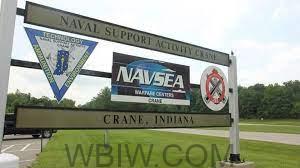
CRANE – IUPUI student Matt Trilus helped one of the nation’s largest naval installations take on one of the greatest national security threats: climate change.
As a McKinney Climate Fellow, Trilus played a leading role this summer in researching and drafting a climate action plan for Naval Support Activity Crane, a heavily forested 64,000-acre site in south-central Indiana that serves as a shore command of the U.S. Navy. For his efforts, he received a formal letter of appreciation from NSA Crane Commander Luis Martinez, plus insight into how sustainability and climate resilience align with U.S. Department of Defense goals.

“I’m a big appreciator of nature,” said Trilus, who is studying biology at the School of Science at IUPUI. “But climate change isn’t just about protecting plants and animals; it’s about protecting people, too. I’m very grateful to NSA Crane for taking this on and for getting to be a part of it.”
According to the 2021 Department of Defense Climate Adaptation Plan, extreme weather events are already costing the department billions of dollars annually and having a negative impact on mission capabilities. In response, a department-wide policy was adopted to consider climate change in decision-making and long-term planning. In alignment with Executive Order 14057, the U.S. Navy has set a goal of achieving a 65% reduction in greenhouse gases by 2030 and net-zero emissions by 2050.
At NSA Crane, a major partner of the conservation-focused Southern Indiana Sentinel Landscape, that process started with talking to stakeholders, assessing built and green infrastructure, evaluating supply chain resilience, and identifying strategies to advance climate mitigation and adaptation.
“What we’re doing right now is planning for the next decade and beyond,” Trilus said. “What projects are the highest priority? What needs to be done first?”
A native Hoosier and former Navy service member, Trilus is familiar with the Indiana landscape and military culture, which gave him a head start on contributing to the climate action plan. Over the course of 12 weeks, he met with 18 stakeholders, documenting projects and risk factors, compiling relevant data spread across multiple government agencies, and conducting an impact analysis and evaluation. Trilus then synthesized this information into a 34-page report that highlights climate-related risks, vulnerabilities and strategies, and recommended solutions.
“We focused on two things the military wants to pioneer: green infrastructure and reducing carbon emissions,” Trilus said. “There are a lot of strategies that are being devised to meet these goals, from something as simple as mowing the grass less in certain places to taking advantage of electric vehicles to install moss roofs that absorb water and carbon.”
Trilus’ experience at NSA Crane complements his post-graduation goals of pursuing a career in environmental science and conservation, a path that crystallized over the course of his travels with the Navy.
“There was a time when we were off the coast and there was a pod of 500 dolphins,” Trilus said. “I was like, ‘Wow, this is crazy.’ All the different wildlife and ecosystems blew me away. And they’re at risk of going away.”
Upon graduation, he’ll have a Bachelor of Science in biology to pair with his commendation from NSA Crane as he springboards toward the next chapter of safeguarding the environment.
“There’s so much out there that needs protection,” Trilus said. “Science, in my mind, has always been the way forward.”
Information: Environmental Resilience Institute Jonathan Hines.



